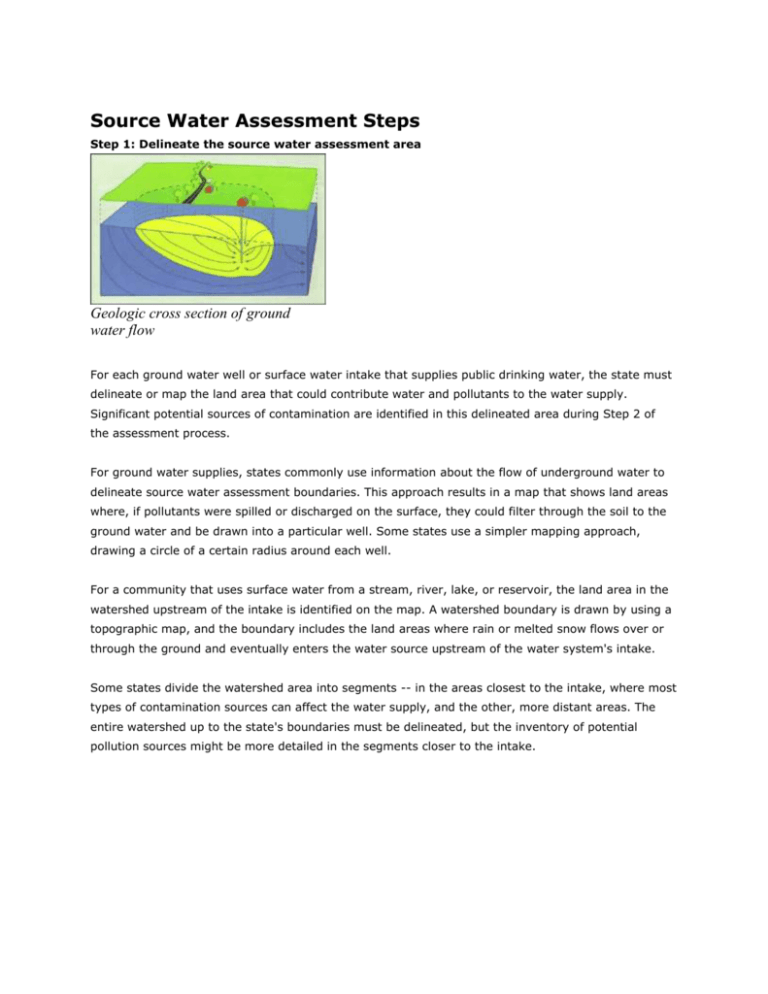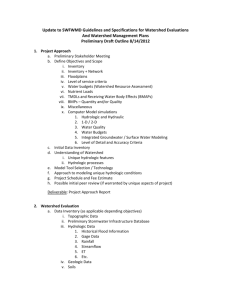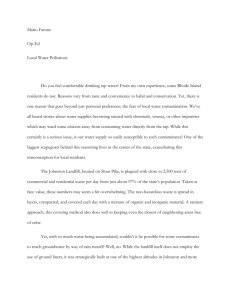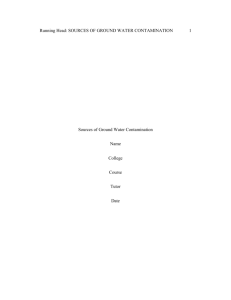Source Water Assessment Steps
advertisement

Source Water Assessment Steps Step 1: Delineate the source water assessment area Geologic cross section of ground water flow For each ground water well or surface water intake that supplies public drinking water, the state must delineate or map the land area that could contribute water and pollutants to the water supply. Significant potential sources of contamination are identified in this delineated area during Step 2 of the assessment process. For ground water supplies, states commonly use information about the flow of underground water to delineate source water assessment boundaries. This approach results in a map that shows land areas where, if pollutants were spilled or discharged on the surface, they could filter through the soil to the ground water and be drawn into a particular well. Some states use a simpler mapping approach, drawing a circle of a certain radius around each well. For a community that uses surface water from a stream, river, lake, or reservoir, the land area in the watershed upstream of the intake is identified on the map. A watershed boundary is drawn by using a topographic map, and the boundary includes the land areas where rain or melted snow flows over or through the ground and eventually enters the water source upstream of the water system's intake. Some states divide the watershed area into segments -- in the areas closest to the intake, where most types of contamination sources can affect the water supply, and the other, more distant areas. The entire watershed up to the state's boundaries must be delineated, but the inventory of potential pollution sources might be more detailed in the segments closer to the intake. Drinking water intake within watershed After the state has completed its assessment for a water system, the community may decide to undertake protection efforts for targeted sources of contamination. An initial step could be to expand on the state's delineation process. Particularly for small ground water systems, where states might not have the resources to conduct a detailed delineation, additional scientific methods can be used to more accurately delineate the area that contributes ground water to the well. Community members can seek assistance from the environmental sciences, geology, or engineering departments of local colleges or from environmental consulting firms in creating more detailed delineations. Sometimes professors, graduate students, or local firms provide these services for a reduced fee or none at all. In addition, local water resource information is often available from other sources such as the federal Natural Resources Conservation Service, the U.S. Geological Survey, and the state's Cooperative Extension Service. Step 2: Conduct an inventory of potential sources of contamination Community groups and public water systems are often especially involved in the second step of an assessment -- identifying potential sources of pollutants that could contaminate the water supply. This inventory usually results in a list and a map of facilities and activities within the delineated area that might release contaminants into the ground water supply (for wells) or into the watershed of the river or lake (for surface water sources). Some examples of potential pollutant sources are landfills, underground or aboveground fuel storage tanks, residential or commercial septic systems, stormwater runoff from streets and lawns, farms that apply pesticides and fertilizers, and sludge disposal sites. This image shows how contaminants reach ground water through septic systems, landfills, abandoned wells, and over application of pesticides and fertilizers. Some states ask communities or public water systems to review the inventory to obtain detailed information about potential contaminant sources. Others use computer databases and focus the inventory on land uses and activities that are currently mapped or regulated. Although the latter approach might not address sources of contaminants that are not currently regulated, such as small livestock areas or auto salvage yards, the database inventories could include industries and sewage treatment plants that discharge wastewater, hazardous waste sites, mining operations, particular land use categories (such as industrial, agricultural and urban areas), and various facilities that have environmental permits. Community groups such as watershed organizations, local environmental committees or scout troops can enhance the state's assessment by conducting site-specific inventories of potential pollutant sources that might not be on state databases or maps. Local inventories might provide information on abandoned dump sites, businesses with septic tanks or floor drains (such as dry cleaners or car repair shops), pesticide mixing and storage areas, golf courses, and other land uses that might release pollutants to ground water or surface water. Community groups can coordinate their local inventory with the state's assessment process or can enhance a completed assessment with a more detailed inventory. Step 3: Determine the susceptibility of the water supply to contamination For the susceptibility analysis, the state combines the inventory results with other relevant information to decide how likely a water supply is to be contaminated by identified potential sources of contamination. This critical step makes the assessments useful for communities because it provides information that local decision makers can use to prioritize their approaches for protecting the drinking water supply. Local information provided to the state by local community groups about contaminant sources, water resource characteristics or environmental management practices may be used in the susceptibility determination process. Some states prioritize the potential for contamination from identified potential contamination sources or specific chemicals that could pollute the water. Other states assign susceptibility rankings of high, medium, or low to the water sources. Determining susceptibility to contamination







